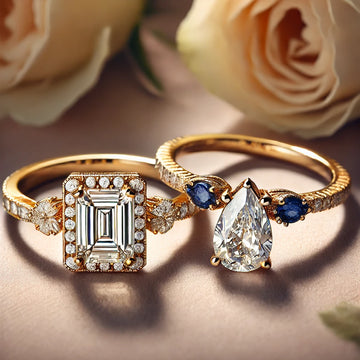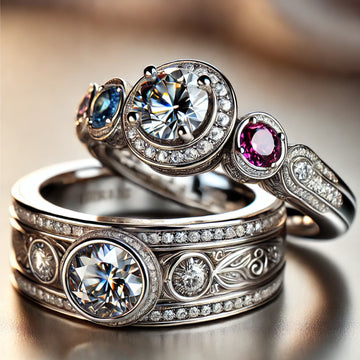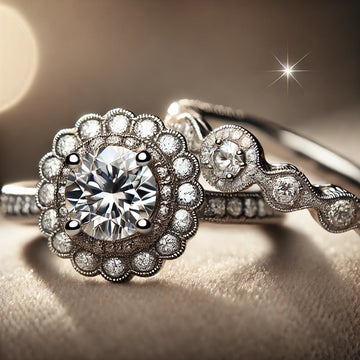Sparkle and Elegance : Iconic Engagement Rings for a Lifetime
by Keyur Koshiya on Oct 18, 2024

https://ivevar.com/products/custom-ring-lab-grown-diamond-vvs1-round-ivevar
1. The History of Engagement Rings
The tradition of giving engagement rings dates back to ancient times. The first recorded use of a diamond engagement ring is often attributed to Archduke Maximilian of Austria, who presented one to Mary of Burgundy in 1477. However, the practice of giving a ring as a symbol of betrothal dates back even further, to ancient Rome. Romans would give their betrothed an iron ring, which symbolized strength and permanence.
In the 19th century, diamonds became more widely associated with engagement rings, thanks in large part to the discovery of diamond mines in South Africa and clever marketing by companies like De Beers. Their 1947 slogan, "A Diamond is Forever," cemented the diamond's place as the ultimate symbol of eternal love.
2. The Symbolism of the Engagement Ring
An engagement ring is rich in symbolism, and each element—whether it’s the shape, gemstone, or metal—can carry meaning. The circular shape of the ring represents eternity, as a circle has no beginning or end. This symbolizes the eternal love and commitment that the couple shares.
The placement of the ring on the fourth finger of the left hand is also symbolic. This tradition is said to originate from the belief that the "vena amoris" or "vein of love" ran directly from this finger to the heart, thus connecting the ring to the seat of love itself.
3. Diamond Engagement Rings
The Classic Choice Diamonds have been the most popular choice for engagement rings for over a century. Their brilliance, durability, and timeless beauty make them an ideal symbol of everlasting love. Diamonds are also the hardest natural substance on Earth, which makes them a practical choice for daily wear. But not all diamonds are created equal. When shopping for a diamond engagement ring, the four Cs—Cut, Color, Clarity, and Carat weight—are essential factors to consider.
- Cut : The cut of a diamond refers to how well it has been shaped and faceted. The quality of the cut has a significant impact on the diamond’s sparkle and brilliance. Common diamond cuts include round, princess, oval, emerald, and cushion cuts.
- Color : Diamonds come in a variety of colors, ranging from completely colorless to shades of yellow or brown. Colorless diamonds (graded D to F) are the rarest and most valuable, but diamonds with slight color (graded G to J) are also highly prized for their beauty.
- Clarity : Clarity refers to the presence of inclusions or blemishes within the diamond. The fewer inclusions a diamond has, the higher its clarity grade, and the more valuable it is. However, many inclusions are not visible to the naked eye, so a slightly lower clarity grade can still result in a stunning diamond.
- Carat Weight : Carat weight measures the size of the diamond. Larger diamonds are rarer and more expensive, but size isn’t the only factor that affects a diamond’s beauty. A well-cut diamond can appear larger and more brilliant than a poorly cut diamond of the same weight.
4. Alternative Gemstones for Engagement Rings
While diamonds are the traditional choice for engagement rings, many couples are now opting for alternative gemstones that better reflect their personal style or values. Some popular alternatives include:
- Sapphires : Sapphires are known for their rich blue color, but they also come in shades of pink, yellow, and white. Sapphires are nearly as durable as diamonds, making them a practical choice for everyday wear. They are often associated with loyalty, making them a meaningful choice for engagement rings.
- Emeralds : Emeralds, with their vibrant green color, symbolize growth, harmony, and new beginnings. They are a softer gemstone compared to diamonds and sapphires, so they require more care to prevent damage.
- Rubies : Rubies are a bold and passionate choice, symbolizing love, vitality, and courage. Their deep red color makes them a striking alternative to traditional diamonds.
- Moissanite : Moissanite is a popular diamond alternative because of its brilliance and affordability. It’s nearly as hard as a diamond and has a fiery sparkle that many people love. Moissanite is often chosen by couples looking for an ethical and budget-friendly option.
- Colored Diamonds : While colorless diamonds are the most popular, colored diamonds—such as yellow, pink, blue, and even black—offer a unique twist on the traditional engagement ring.
5. Popular Engagement Ring Styles
The style of the engagement ring is just as important as the choice of gemstone. Engagement rings come in a variety of designs, each with its own distinct look and feel. Some of the most popular styles include:
- Solitaire : The solitaire is the most classic and timeless engagement ring style. It features a single gemstone, typically a diamond, set on a simple band. This style is elegant and focuses all attention on the brilliance of the gemstone.
- Halo : The halo design features a center stone surrounded by a ring of smaller diamonds or gemstones. This style enhances the appearance of the center stone, making it look larger and more radiant.
- Three-Stone : As the name suggests, a three-stone engagement ring features three stones, typically representing the past, present, and future of the couple’s relationship. The stones can be the same type of gemstone or different types, allowing for a personalized look.
- Vintage : Vintage engagement rings are inspired by styles from previous eras, such as the Victorian, Edwardian, or Art Deco periods. These rings often feature intricate details, such as filigree or milgrain, and may use antique gemstones or cuts.
- **Bezel**: In a bezel setting, the center stone is encircled by a thin metal rim that holds it securely in place. This modern and sleek style offers a more contemporary look and provides added protection for the gemstone.
- **Pavé**: Pavé engagement rings are encrusted with small diamonds along the band, creating a sparkling effect that adds extra brilliance to the ring. This style is often paired with a solitaire or halo design for maximum impact.
6. Metals for Engagement Rings
The metal used for the engagement ring band plays an important role in the overall look and feel of the ring. Some of the most popular metals for engagement rings include:
- Platinum : Platinum is a rare and durable metal that is often chosen for its luxurious feel and hypoallergenic properties. Its natural white color enhances the brilliance of diamonds and other gemstones.
- White Gold : White gold is a popular and affordable alternative to platinum. It has a similar appearance but is lighter in weight. White gold is typically alloyed with other metals to enhance its strength and is often plated with rhodium for a shiny finish.
- Yellow Gold : Yellow gold is a classic choice for engagement rings. Its warm, rich hue complements a wide range of gemstones and styles. Yellow gold is available in various karats, with 18k and 14k being the most common for engagement rings.
- Rose Gold : Rose gold has gained popularity in recent years for its romantic, blush-pink hue. This metal is created by alloying gold with copper, which gives it its distinctive color. Rose gold is both unique and timeless, making it a great choice for modern couples.
- Mixed Metals : For a more personalized look, some couples choose engagement rings that feature mixed metals. For example, a ring might have a platinum band with rose gold accents or a white gold band with a yellow gold setting. This creates a unique, custom feel while incorporating multiple tones.
7. Ethical Considerations
Conflict-Free and Sustainable Rings With growing awareness about ethical sourcing and environmental impact, many couples are choosing engagement rings that align with their values. Ethical engagement rings focus on the sourcing of materials, particularly diamonds and gemstones, to ensure they are conflict-free and mined under fair labor conditions.
- Conflict-Free Diamonds : Conflict diamonds, also known as blood diamonds, are diamonds that are mined in war zones and sold to finance armed conflict against governments. The Kimberley Process was established to prevent the trade of conflict diamonds, but some consumers seek further assurance by choosing diamonds that are certified as conflict-free by organizations like the Responsible Jewelry Council.
- Lab-Grown Diamonds : Lab-grown diamonds are an increasingly popular ethical alternative to natural diamonds. These diamonds are created in a controlled environment using advanced technology that replicates the natural diamond-growing process. Lab-grown diamonds are virtually identical to natural diamonds but come with a lower environmental impact and price tag.
- Sustainable Metals : Some jewelers offer engagement rings made from recycled metals, which reduces the demand for newly mined gold or platinum. Choosing a ring made from sustainable materials is an eco-friendly option for environmentally conscious couples.
8. Customizing Your Engagement Ring
For couples who want something truly unique, customizing an engagement ring is a great option. Many jewelers offer the ability to design a ring from scratch or modify an existing design to suit personal tastes. Customization options include selecting the gemstone, metal, setting, and band style, as well as adding personal touches like engraving or incorporating family heirlooms.

 Engagement Ring
Engagement Ring  Anniversary Rings
Anniversary Rings Solitaire Rings
Solitaire Rings Halo Rings
Halo Rings Men's Ring
Men's Ring Toi Moi Ring
Toi Moi Ring Three Stone Rings
Three Stone Rings Nature Inspired Rings
Nature Inspired Rings Rose Cut Diamond Rings
Rose Cut Diamond Rings Fancy Color Rings
Fancy Color Rings Antique Cut Diamond Rings
Antique Cut Diamond Rings Wedding rings
Wedding rings All Lab Grown Diamond Ring
All Lab Grown Diamond Ring Engagement Ring
Engagement Ring  Three Stone Rings
Three Stone Rings Daily Wear
Daily Wear Fancy Color Rings
Fancy Color Rings Antique Cut Diamond Rings
Antique Cut Diamond Rings Earrings
Earrings Bracelet
Bracelet Pendent
Pendent Necklace
Necklace Men's Ring
Men's Ring Bridal Sets
Bridal Sets Rings
Rings Earrings
Earrings Tennis chain
Tennis chain Custom Pendent
Custom Pendent Custom Ring
Custom Ring Custom Teeth Grillz
Custom Teeth Grillz Round
Round Oval
Oval Cushion
Cushion Marquise
Marquise Pear
Pear Emerald
Emerald Heart
Heart Princess
Princess Rose Cut
Rose Cut Radiant
Radiant Antique Cut
Antique Cut



